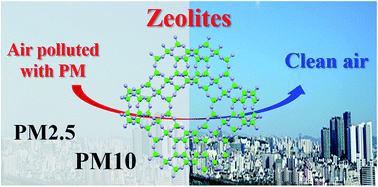Effective removal of particulate matter from air by using zeolite-coated filters†
Abstract
Removal of particulate matter (PM) from air is very important for a safe environment and sound health. In this work, we first applied zeolites, after coating onto substrates such as cotton and polyester, in PM removal from air and confirmed that zeolites, especially aluminous ones, could be very effective in the removal of PM. For example, NaX/cotton (NaX: ∼20 wt% of cotton) showed 3.6- and 3.4-times the removal efficiency (RE) of bare cotton for PM2.5 and PM10 elimination, respectively, even though the pressure drop increased only slightly (by 9 Pa). Moreover, NaX was much more effective than the widely applied metal–organic frameworks (MOFs) such as ZIF-8, UiO-66 and MOF-74 (or CPO-27), even though the porosity of NaX was much lower than those of the applied MOFs. Importantly, the quality factor and RE of the filters increased linearly with the increasing Al contents of the applied zeolites (with the same faujasite structure, namely NaY and NaX), suggesting the important role of Al and charge-compensating Na+ in PM elimination from air. Finally, it could be suggested that the PM removal is due to electrostatic interactions and aluminous zeolites (with charge-balancing cations) can be effectively used in the PM removal from air.



 Please wait while we load your content...
Please wait while we load your content...